Interruptions are absolutely plaguing the workweek. Many professionals are so accustomed to the nonstop flow, they don’t even notice the chat pings, phone alerts, meeting calls, or ‘quick question’ interruptions that they’re bombarded with every day. And while it might seem like it only takes a second to check your inbox, reply to a Slack message, or set aside what you’re doing to knock out that last -minute request – research has found that interruptions can actually end up costing you 6 hours a day.
The sad truth is the average professional is interrupted every 5-15 minutes and 80% of these interruptions are unimportant. And unfortunately, the real problem of interruptions goes beyond just the initial distraction. Thanks to context switching, it actually takes the average person 23 minutes and 15 seconds to bring their focus back to what they were originally doing before they were interrupted. In this article we’re going to review common workplace distractions, and walk through effective strategies to manage interruptions so you can get those valuable hours back.
The problem of interruptions at work
Context switching happens when you shift focus from one task to a different, unrelated task, and interruptions are often the cause for this productivity-squashing context switching. You might be in the middle of writing a marketing launch strategy and receive a Slack message from a coworker about an entirely different project. When you pause what you’re doing to answer – you have effectively switched your concentration to this new task, or ‘context’.
Negative effects of interruptions:
- Wastes time having to get back on task after the initial interruption.
- Exhausts the brain from excessive cognitive processing and information overload.
- Causes stress by increasing cortisol levels in the body and feeling overrun.
- Produces lower quality work thanks to depleted energy and lack of concentration.
- Compromises priorities by distracting focus from the things that are most important.
- Reduces motivation because of overwhelm and reduced sense of accomplishment.
- Hinders deep work by not allowing enough focus time on tasks.
The average professional switches between 9.4 apps for their daily work, sits through 5.1 meetings a day, and spends 10.4% of their workday emailing and another 5.2% of their time messaging. That doesn’t exactly leave much opportunity for heads-down work on the important tasks you have to do. In fact, our 2022 Task Management Trends Report found that only 50.2% of managers' task time is spent on focused work, and individual contributors only get 2.24 hours of actually productive task work out of the day, on average.
6 workplace interruptions (and how to manage them)
Let’s take a look at some of the most common causes of interruption at work, and tips to better manage them.
1. Smartphones
The first item on our list shouldn’t come as a surprise. In fact, there’s a good chance you’re reading this article on your phone right now! The average person checks their phone 63 times a day, with heavy phone users hitting up to 86 daily interactions. And reaching for the phone to check a notification, or even just out of habit, can easily result in a 10-minute rabbit hole on top of the time lost to context switching.
Try removing your phone from your workspace, or disabling notifications during work hours. If you must check your phone during the day, you might find it helpful to limit usage to your lunch break or schedule a couple times a day to get caught up on any important notifications. There are also tools like Freedom.to which block apps and devices for a set amount of time to help you reclaim your focus if you need a little extra willpower.
2. Email & chat messages
Busy professionals can always count on a constant flow of messages in their inbox and on chat messaging platforms. And while they’re amazing tools to connect with dispersed teams, partners, and customers – these work-related interruptions can seriously hinder productivity when they pull you away from focused work.
So instead of checking your email every 5 minutes, or jumping at the sound of every ping, try scheduling time in the morning and afternoon to “catch-up” on your inboxes and reply to messages. For chat platforms, it’s actually easier to limit disruptive notifications in settings, or turn them off entirely when you’re busy. Alternatively, creating more transparency around your availability can actually help make your team aware that you’re busy – even when your profile says you’re active. Integrating your messaging platform with your calendar to automatically update your status with what you’re currently doing (like this one for Google Calendar and Slack) helps to deter well-meaning interruptions while you’re in meetings or working on tasks.
3. Inefficient workflows
Functioning across a dense stack of work apps and platforms is super common for today’s workers. At minimum, you have your project management tool, email, messaging platform, video conferencing, calendar, document manager, and productivity apps to keep your work-life on track. But many of those tools are also constantly updating you with notifications throughout the day. And while it might seem helpful because they are work-related, these pings for your attention can be a distraction when they’re interrupting you during important work. Luckily the amazing benefit of all of these advanced work apps is that there’s always a way to connect them together to limit interruptions.
Optimizing your workflows through integrations is a great way to maximize productivity by streamlining notifications, better communicating your availability to discourage interruptions from your team, and reducing time wasted manually replicating information across apps. For example, you can automatically block time to work on your tasks with a productivity app like Reclaim.ai which syncs your task list from project management apps right to Google Calendar, so you don’t have to switch between two (or more) tools to organize your day. Try browsing through the Google Workspace Marketplace, Outlook Marketplace, Slack App Directory, and any other ‘marketplaces’ of tools you already use to see if there are similar integrations available for your app-stack that can help streamline your workflow.
4. Workspace disorganization
Whether you’re working in the office or remotely at home – keeping your workspace organized can have a big impact on your productivity. Both your physical and digital space can become a distraction and a source of anxiety when you’re always losing important things on your desk(top) - and constantly end up interrupting you from your important work.
Try to dedicate your workspace exclusively to work, and spend a couple minutes at the end of your workday tidying up your desk. You may also find it helpful to make a weekly habit of organizing your computer folders, sorting through your email inbox, and filing away any documents that have piled up.
5. Unproductive meetings
Think your workweeks have gotten a little more intense over the past couple of years? There’s actually been a 69.7% increase in meetings since the start of the pandemic, and there’s no doubt excessive unproductive meetings are an expensive interruption, not to mention time waste, that all too often keeps you from high-value work.
Practice respectfully saying “no” to unproductive meetings that you don’t have the time or bandwidth for. While you may feel like you’re letting people down, you’re actually doing the best thing for your company by reserving your time for the responsibilities of your actual role! But instead of just declining with no explanation, shoot a short response back to the invite to let them know that you would attend if you had time, but really need to focus on XYZ at this time. You can also try implementing a no-meeting day once a week dedicated to independent task work so you can get things done.
6. Multitasking
You probably wouldn’t have guessed multitasking would show up on an interruptions list, but one of the biggest interruptions you actually face is from yourself! Only 2% of the population can effectively multitask, yet many of us seem to think we are part of this select group. In reality, the majority of people (a whopping 98%) cannot multitask at all. While you can probably juggle a handful of shallow work to-dos at one time like making calls, catching up on emails, or entering data – you’re not going to be able to work productively during deep work sessions across multiple cognitively-demanding tasks.
Deep work is distraction-free focused work on a task. But dedicating any significant amount of time to distraction-free work is not easy when you’re getting interrupted every 5-15 minutes! Time blocking is the habit of ‘blocking’ your calendar with everything that you need to do in a day – boosting productivity by directing your focus to a single task at a time. Not only does this technique allow you to defend time in your busy schedule for your priorities, but it also communicates your availability with your team to (hopefully) reduce interruptions when they can see you’re busy.
Make more time by reducing distractions 🙌
While companies are trying to create productive systems in this new age work – sometimes the very things that are supposed to be helping teams can actually become the distractions that pull from actual task work. (Hello, lots of check-in meetings and a little green dot to exclaim your availability).
By approaching your workflow with a little self-discipline, and a little help from some productivity tools, you can start to manage interruptions at work by blocking real time for your priorities and better communicating your true availability with others and yourself.
Did we miss a great tip on how to manage interruptions at work? Tweet us @reclaimai to start a conversation!


































